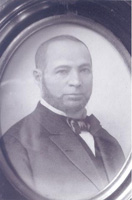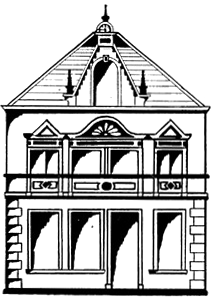| |
Dorsten 1820:
»Violence in the synagogue itself« |

 |
|
In June 1820 four of the eight Jewish families
in Dorsten complained to the mayor, “...that the other
families, led by Samson Nathan Eisendrath (1785-1857), no longer
wanted to attend the services at the synagogue. They said that
without any official authority Eisendrath had moved the synagogue
to his own house and taken the Torah scroll, other “synagogue
utensils” and money from the poor box. As a service could
only take place, they said, when ten man were present and in
order to “put Jewish matters right”, the people
complaining demanded punishment for the renegades. |
In 1808 two Jewish families were allowed to settle
in Dorsten. For centuries Jews had been banned from the towns of
Westphalia but this meant that a new Jewish community could now
develop.
| The “Dorsten Synagogue Dispute”
of 1820 occupied the authorities intensively: The synagogue
was a simple prayer room which the Jewish householders had established
in 1809 in a private Christian house. There had obviously been
conflicts for some time. On 29 June 1820 the mayor wrote to
the regional rabbi Abraham Sutro in Münster: “Complaints
and disputes among the local Jewish congregation do indeed occur
frequently – but as much as I would like to obtain peace,
I do not feel that I am in a position to judge the reason or
lack of reason for these quarrels (…) as the Jewish congregation
has its own laws with which I am not familiar and about which
I have been informed by one side in one way and by the other
side in another way.” (Pic.: Drawing
of the Synagogue’s facade (1924)) |
|
 |
Disputes and split
The regional rabbi first requested the mayor to “seriously
call on the members of the said congregation to maintain strict
law and order and to say that anyone person behaving in an unbecoming
manner in the synagogue would be punished in accordance with the
full rigour of the law.”
Disputes, which according to the mayor “mainly occur through
non-compliance with private Jewish laws” had already lead
to a split at Passover 1820. As “there had even been violence
in the synagogue itself”, on 9 September 1820 he again asked
the regional rabbi to arbitrate personally.
When he was officially questioned Samson Nathan Eisendrath, who
in 1816 was appointed “Head of the Jewish Community”
by the Royal Government of Münster, stated that he now wanted
to bring an action against the complainants. Without the personal
involvement of the regional rabbi conciliation no longer seemed
possible. Samson Nathan made the necessary contribution towards
the travel expenses which was to be divided up among the congregation
later.
Sutro appears to have been in Dorsten in late autumn 1820 but he
did not achieve anything. When Mayor Gahlen wanted to collect the
contribution towards the travel expenses from the Jewish families,
they refused “because the regional rabbi had not sufficiently
settled the points at issue”.

 |
|
|
| |
| Charter of the Jewish
commmunity in Dorsten (1856) |
|
Charter of the Jewish commmunity
in Dorsten (1856) |
 |
|
|